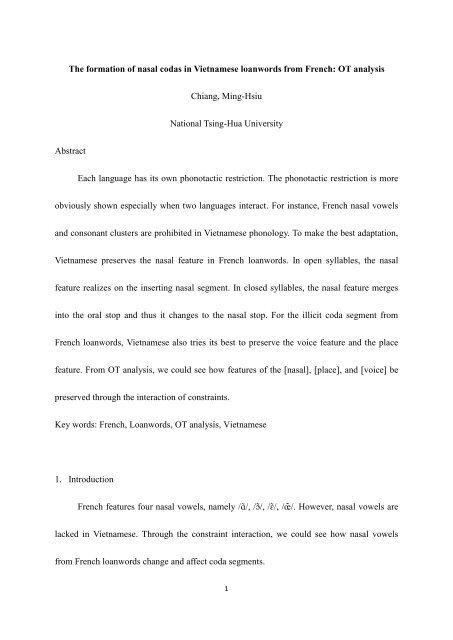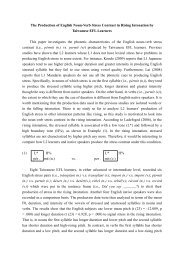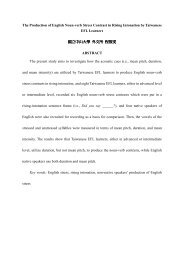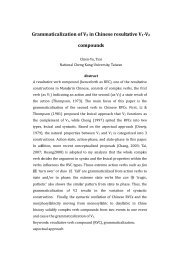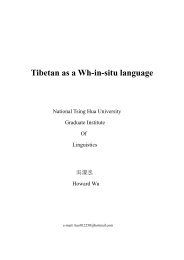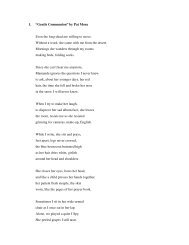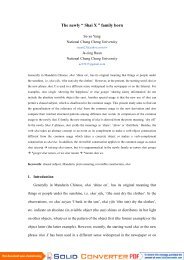The formation of nasal codas in Vietnamese loanwords from French ...
The formation of nasal codas in Vietnamese loanwords from French ...
The formation of nasal codas in Vietnamese loanwords from French ...
You also want an ePaper? Increase the reach of your titles
YUMPU automatically turns print PDFs into web optimized ePapers that Google loves.
<strong>The</strong> <strong>formation</strong> <strong>of</strong> <strong>nasal</strong> <strong>codas</strong> <strong>in</strong> <strong>Vietnamese</strong> <strong>loanwords</strong> <strong>from</strong> <strong>French</strong>: OT analysisChiang, M<strong>in</strong>g-HsiuNational Ts<strong>in</strong>g-Hua UniversityAbstractEach language has its own phonotactic restriction. <strong>The</strong> phonotactic restriction is moreobviously shown especially when two languages <strong>in</strong>teract. For <strong>in</strong>stance, <strong>French</strong> <strong>nasal</strong> vowelsand consonant clusters are prohibited <strong>in</strong> <strong>Vietnamese</strong> phonology. To make the best adaptation,<strong>Vietnamese</strong> preserves the <strong>nasal</strong> feature <strong>in</strong> <strong>French</strong> <strong>loanwords</strong>. In open syllables, the <strong>nasal</strong>feature realizes on the <strong>in</strong>sert<strong>in</strong>g <strong>nasal</strong> segment. In closed syllables, the <strong>nasal</strong> feature merges<strong>in</strong>to the oral stop and thus it changes to the <strong>nasal</strong> stop. For the illicit coda segment <strong>from</strong><strong>French</strong> <strong>loanwords</strong>, <strong>Vietnamese</strong> also tries its best to preserve the voice feature and the placefeature. From OT analysis, we could see how features <strong>of</strong> the [<strong>nasal</strong>], [place], and [voice] bepreserved through the <strong>in</strong>teraction <strong>of</strong> constra<strong>in</strong>ts.Key words: <strong>French</strong>, Loanwords, OT analysis, <strong>Vietnamese</strong>1. Introduction<strong>French</strong> features four <strong>nasal</strong> vowels, namely / /, / /, / /, / /. However, <strong>nasal</strong> vowels arelacked <strong>in</strong> <strong>Vietnamese</strong>. Through the constra<strong>in</strong>t <strong>in</strong>teraction, we could see how <strong>nasal</strong> vowels<strong>from</strong> <strong>French</strong> <strong>loanwords</strong> change and affect coda segments.1
As the colony ruled by <strong>French</strong>, <strong>Vietnamese</strong> loans a number <strong>of</strong> words <strong>from</strong> <strong>French</strong> toadapt the <strong>French</strong> culture. <strong>Vietnamese</strong> derived <strong>nasal</strong> <strong>codas</strong> are <strong>from</strong> three sources. <strong>The</strong> firstone is <strong>from</strong> the <strong>nasal</strong> vowel assimilation. In open syllables, <strong>Vietnamese</strong> changes <strong>French</strong> <strong>nasal</strong>vowels <strong>in</strong>to oral counterparts and then <strong>in</strong>serts a <strong>nasal</strong> segment to compensate the <strong>nasal</strong> featureloss. At the same time, the place feature <strong>of</strong> the <strong>nasal</strong> vowel also spreads to the <strong>in</strong>sert<strong>in</strong>g <strong>nasal</strong>segment to do place agreement <strong>in</strong> the rime doma<strong>in</strong>.<strong>The</strong> second source is to change an oral stop follow<strong>in</strong>g a <strong>nasal</strong> vowel to a <strong>nasal</strong> stop. Inclosed syllables, however, only the <strong>nasal</strong> feature spreads but the place feature <strong>of</strong> the stoprema<strong>in</strong>s the same. No rime harmony happens this time.<strong>The</strong> third source is <strong>from</strong> the lateral coda [l] or the [l] consonant cluster coda <strong>in</strong> <strong>French</strong>.In <strong>Vietnamese</strong>, only the voiceless stops [p, t, c, k], the <strong>nasal</strong>s [m, n, ɲ, ŋ], and complexsegments [kp, ŋm] are allowed <strong>in</strong> the coda position 1 . Thus, the lateral coda [l] <strong>from</strong> <strong>French</strong><strong>loanwords</strong> is illicit. F<strong>in</strong>ally, lateral coda [l] changes to the <strong>nasal</strong> [n] <strong>in</strong> <strong>Vietnamese</strong>.This analysis is OT-based. Through the <strong>in</strong>teraction <strong>of</strong> constra<strong>in</strong>ts, we could see thepreferred strategies adopted <strong>in</strong> <strong>Vietnamese</strong> phonology. Section 2 compares <strong>French</strong> consonantsand vowels with <strong>Vietnamese</strong> counterparts. Section 3 discusses the environment <strong>of</strong> the <strong>nasal</strong>coda. In section 4, OT analysis is adopted. Section 5 is the conclusion.1 Laurence C. Thompson. 1987.2
2. <strong>The</strong> consonants and vowels <strong>of</strong> <strong>French</strong> and <strong>Vietnamese</strong>2.1 <strong>French</strong> consonantsTable 1: <strong>French</strong> consonant chart2.2 <strong>Vietnamese</strong> consonantsTable 2: <strong>Vietnamese</strong> consonant chart3
Although <strong>Vietnamese</strong> conta<strong>in</strong>s abundant consonant phonemes, compared with <strong>French</strong>,<strong>Vietnamese</strong> still lacks four k<strong>in</strong>ds <strong>of</strong> consonants, such as velar plosive /ɡ/, palatal fricatives/ʃ,ʒ/, trills /r, ʀ/, and palatal approximants /ɥ/.2.3 <strong>French</strong> vowelsTable 3: <strong>French</strong> vowel chart2.4 <strong>Vietnamese</strong> vowels 2 Table 4: <strong>Vietnamese</strong> consonant chartCompared with <strong>French</strong>, <strong>Vietnamese</strong> lacks four k<strong>in</strong>ds <strong>of</strong> vowels, such as upper-mid2 I adopt Han‟s (1966) vowel description <strong>of</strong> Hanoi <strong>Vietnamese</strong> for the reason that she uses acoustic analysis. Forloanword adaptation, segment correspondent may better be acoustics-based.4
ounded vowel /ø/, lower-mid rounded vowel / /, low back vowel / /, and <strong>nasal</strong> vowels / /,/ /, / /, / /. We will focus on the <strong>Vietnamese</strong> adaptation on <strong>nasal</strong> vowels <strong>from</strong> <strong>French</strong>.3. <strong>The</strong> environment <strong>of</strong> the <strong>nasal</strong> coda.S<strong>in</strong>ce <strong>Vietnamese</strong> does not have <strong>nasal</strong> vowels, <strong>French</strong> <strong>nasal</strong> vowels will be changed. Inopen syllables, the <strong>nasal</strong> vowel changes to the pattern <strong>of</strong> an oral counterpart followed by a<strong>nasal</strong> coda. In this way, the pattern is adjusted to <strong>Vietnamese</strong> phonotactic constra<strong>in</strong>tssimultaneously keep<strong>in</strong>g the orig<strong>in</strong>al feature <strong>of</strong> the <strong>French</strong> <strong>nasal</strong> vowel. Moreover, the <strong>nasal</strong>vowel not only spreads the <strong>nasal</strong> feature but also spreads the place feature. I only list the data<strong>of</strong> three <strong>nasal</strong> vowels, / /, / /, and / / because <strong>of</strong> the lack <strong>of</strong> data <strong>of</strong> the ench nasa / /,shown as <strong>in</strong> Table 5.Table 5. Nasal <strong>in</strong>sertion <strong>in</strong> <strong>Vietnamese</strong>In the case <strong>of</strong> the pattern <strong>of</strong> <strong>nasal</strong> vowels follow<strong>in</strong>g the stops <strong>in</strong> <strong>French</strong>, based on thesame reason <strong>of</strong> the lack <strong>of</strong> <strong>nasal</strong> vowels, the stop consonants follow<strong>in</strong>g the <strong>nasal</strong> vowels willbe changed <strong>in</strong>to the <strong>nasal</strong>s <strong>in</strong> <strong>Vietnamese</strong> to preserve the <strong>nasal</strong> feature. This time, the <strong>nasal</strong>feature is not realized as an <strong>in</strong>dependent segment. <strong>The</strong> follow<strong>in</strong>g stop consonant changes <strong>in</strong>to5
its homorganic <strong>nasal</strong> <strong>in</strong>stead. However, if the follow<strong>in</strong>g segment is a fricative, its placefeature will not be preserved and it will be assimilated by the preced<strong>in</strong>g vowel <strong>in</strong> place. Forexample, [e.s s] changes to [et.sɐŋ] <strong>in</strong>stead <strong>of</strong> [et.sɐn]. Aga<strong>in</strong>, we lack the data / / followedby stop consonants. <strong>The</strong> data <strong>of</strong> the three <strong>nasal</strong> vowels / /, / / and / / are listed <strong>in</strong> Table 6.Table 6. Nasal replacement <strong>in</strong> <strong>Vietnamese</strong>No rhyme harmony happened when a stop follow<strong>in</strong>g a <strong>nasal</strong> vowel. <strong>The</strong> place feature<strong>of</strong> the stop is still kept and then it changes to its homorganic <strong>nasal</strong>. That is to say, the placefeature <strong>of</strong> the stop is highly preserved.<strong>The</strong> third source is <strong>from</strong> the coda [l] <strong>in</strong> <strong>French</strong>. S<strong>in</strong>ce both the coda [l] and the [l]consonant cluster coda are not allowed <strong>in</strong> <strong>Vietnamese</strong>, they need to be changed. We f<strong>in</strong>d thatthey are adapted as <strong>nasal</strong> [n] <strong>in</strong> <strong>Vietnamese</strong>, illustrated as Table 7 and 8.Table 7. Coda [l] ~ [n]alternation6
Table 8. Consonant cluster <strong>codas</strong> led by [l] are replaced by [n]Consonant clusters <strong>in</strong> the coda position are complicated because <strong>Vietnamese</strong> <strong>codas</strong> arelimited. In this research, we only concern about <strong>nasal</strong> <strong>codas</strong>. <strong>The</strong> adaptation <strong>of</strong> otherconsonant <strong>codas</strong> or consonant cluster <strong>codas</strong> will not be discussed <strong>in</strong> details.4. OT analysis4.1. <strong>The</strong> <strong>nasal</strong> feature preservationIn this research, OT analysis is adopted. We could see how the constra<strong>in</strong>ts <strong>in</strong>teract.Now we start <strong>from</strong> the <strong>nasal</strong> feature preservation <strong>in</strong> <strong>Vietnamese</strong>.S<strong>in</strong>ce <strong>Vietnamese</strong> does not have <strong>nasal</strong> vowels, we need a markedness constra<strong>in</strong>t,namely *V NASAL .(1) *V NASAL (context-free markedness constra<strong>in</strong>t)Vowels must not be <strong>nasal</strong>.We need a faithfulness constra<strong>in</strong>t to preserve the <strong>nasal</strong> feature, namely M AX -N ASAL .(2) M AX -N ASAL (faithfulness constra<strong>in</strong>t)Every [<strong>nasal</strong>] <strong>in</strong> the <strong>in</strong>put has a correspondent <strong>in</strong> the output.7
<strong>The</strong> markedness constra<strong>in</strong>t, *V NASAL and the faithfulness constra<strong>in</strong>t, M AX -N ASAL haveno crucial rank<strong>in</strong>g. Revers<strong>in</strong>g the order <strong>of</strong> rank<strong>in</strong>g makes no difference.(3) *V NASAL >> M AX -N ASAL(4) M AX -N ASAL >> *V NASALHowever, to preserve the <strong>nasal</strong> feature could lead to another problem. S<strong>in</strong>ce only <strong>nasal</strong>consonants are allowed <strong>in</strong> <strong>Vietnamese</strong>, the strategy to preserve the <strong>nasal</strong> feature for<strong>Vietnamese</strong> could be the <strong>nasal</strong> consonant <strong>in</strong>sertion. This strategy could result <strong>in</strong> anotherviolation <strong>of</strong> the faithfulness constra<strong>in</strong>t, namely D EP -C.(5) D EP -C (faithfulness constra<strong>in</strong>t)Output consonants must have <strong>in</strong>put co espondents. (“No C epenthesis”)D EP -C should be demoted below *V NASAL and M AX -N ASAL to get the optimal candidate.8
(6) *V NASAL >> D EP -C(7) M AX -N ASAL >> D EP -C<strong>The</strong>ir rank<strong>in</strong>g should be *V NASAL , M AX -N ASAL >> D EP -C.In CV syllable structures, <strong>nasal</strong> <strong>in</strong>sertion is adopted to preserve the <strong>nasal</strong> feature loss.However, <strong>in</strong> CVC syllable structures, the post-vowel oral consonant is changed to the <strong>nasal</strong>consonant, <strong>in</strong>stead <strong>of</strong> the <strong>nasal</strong> segment <strong>in</strong>sertion. Thus, we need another faithfulnessconstra<strong>in</strong>t, namely I DENT -IO (<strong>nasal</strong>).(8) I DENT -IO (<strong>nasal</strong>) (faithfulness constra<strong>in</strong>t)Correspondent segments <strong>in</strong> <strong>in</strong>put and output have identical values for [<strong>nasal</strong>].<strong>The</strong> constra<strong>in</strong>t I DENT -IO (<strong>nasal</strong>) should be ranked below the constra<strong>in</strong>ts above .(9) *V NASAL >> I DENT -IO (<strong>nasal</strong>)9
(10) M AX -N ASAL >> I DENT -IO (<strong>nasal</strong>)(11) D EP -C >> I DENT -IO (<strong>nasal</strong>)Until now, the rank<strong>in</strong>g is *V NASAL , M AX -N ASAL >> D EP -C >> I DENT -IO (<strong>nasal</strong>).<strong>The</strong> strategy to preserve the <strong>nasal</strong> feature, except to do the <strong>nasal</strong> <strong>in</strong>sertion after the oralvowel, <strong>in</strong>sert<strong>in</strong>g the <strong>nasal</strong> feature to the adjacent consonant could be another alternative.However, we see /b b/→[bom] but never /b b/→[mob] <strong>in</strong> <strong>Vietnamese</strong>. Kager (2004) statesthat the coda neutralization could be regarded as the positional faithfulness <strong>in</strong> onsets.Moreover, he proposes that<strong>The</strong>re is an overwhelm<strong>in</strong>g typological tendency for neutraliz<strong>in</strong>g assimilation to preserve feature values<strong>of</strong> segments <strong>in</strong> „sa ient‟ position (onsets, <strong>in</strong>itia sy ab es, oot segments, etc.), at the expense <strong>of</strong> segments <strong>in</strong>other positions (coda, medial syllables, affix segments, etc.) (Page 408)S<strong>in</strong>ce the onset position is so salient that it is hard for the onset to be subject to achange, we need a positional faithfulness constra<strong>in</strong>t, namely I DENT -IO (<strong>nasal</strong>, onset).10
(12) I DENT -IO (<strong>nasal</strong>, onset) (Positional faithfulness constra<strong>in</strong>t)An output segment stand<strong>in</strong>g <strong>in</strong> the onset position <strong>of</strong> a syllable has the same valuefor [<strong>nasal</strong>] as its <strong>in</strong>put correspondent.I DENT -IO (<strong>nasal</strong>, onset) is undom<strong>in</strong>ated <strong>in</strong> <strong>Vietnamese</strong> phonology s<strong>in</strong>ce the onsetsegment is never changed <strong>in</strong> loanword adaptation.Now, we see the <strong>in</strong>teraction between one markedness constra<strong>in</strong>t, *V NASAL and fourfaithfulness constra<strong>in</strong>ts, M AX -N ASAL , I DENT -IO (<strong>nasal</strong>, onset), D EP -C, and I DENT -IO (<strong>nasal</strong>). Forthe preservation <strong>of</strong> the <strong>nasal</strong> feature, <strong>Vietnamese</strong> applies four faithfulness constra<strong>in</strong>ts toprevent the change <strong>of</strong> the <strong>nasal</strong> feature or the <strong>nasal</strong> <strong>in</strong>sertion.(13) markedness constra<strong>in</strong>t faithfulness constra<strong>in</strong>ts*V NASAL M AX -N ASAL (prevent <strong>nasal</strong> vowel to become the oral vowel)I DENT -IO (<strong>nasal</strong>, onset) (prevent the onset to become the <strong>nasal</strong> segment)D EP -C (prevent the <strong>nasal</strong> consonant <strong>in</strong>sertion)I DENT -IO (<strong>nasal</strong>) (prevent the segment to become the <strong>nasal</strong>)For the dom<strong>in</strong>ated constra<strong>in</strong>ts, D EP -C and I DENT -IO (<strong>nasal</strong>), the <strong>nasal</strong> consonant<strong>in</strong>sertion and the <strong>nasal</strong> feature change are both the possible ways to preserve the <strong>nasal</strong> feature.D EP -C >> I DENT -IO (<strong>nasal</strong>) also tells that the change <strong>of</strong> the <strong>nasal</strong> feature is the most possibleway to preserve the <strong>nasal</strong> feature. If there is no exist<strong>in</strong>g coda segment, the way to preservethe <strong>nasal</strong> feature is to do the <strong>nasal</strong> consonant <strong>in</strong>sertion.11
4.2. <strong>The</strong> place feature preservationExcept the <strong>nasal</strong> feature preservation, we also f<strong>in</strong>d that the place feature <strong>of</strong> the stop ispreserved <strong>in</strong> the coda position. In the CV structure, the way to preserve the <strong>nasal</strong> feature is todo the <strong>nasal</strong> consonant <strong>in</strong>sertion. <strong>The</strong> next problem is which <strong>nasal</strong> consonant should bechosen. To take [fr ] →[f ɲ] for example, We f<strong>in</strong>d that the <strong>nasal</strong> [ɲ] agrees <strong>in</strong> place with itspreced<strong>in</strong>g vowel [ ]. Thus, a rhyme harmony constra<strong>in</strong>t is needed, namely A GREE (rime) pl .(14) A GREE (rime) pl (context-sensitive markedness constra<strong>in</strong>t)<strong>The</strong> segments <strong>in</strong> the rime <strong>of</strong> the syllable agree <strong>in</strong> place.S<strong>in</strong>ce it is a markedness constra<strong>in</strong>t which is likely to change the place feature, we needa faithfulness constra<strong>in</strong>t to preserve the place feature. In our data, only the place feature <strong>of</strong> thestop consonant is preserved. We need a faithfulness constra<strong>in</strong>t, namely I DENT -IO (stop,place) 3456 .(15) I DENT -IO(stop, place)<strong>The</strong> specification for place <strong>of</strong> articulation <strong>of</strong> an <strong>in</strong>put stop segment must be preserved<strong>in</strong> its output correspondent.3 <strong>The</strong> us<strong>in</strong>g <strong>of</strong> a cover constra<strong>in</strong>t is for the follow<strong>in</strong>g reason. For example, [b b]→[bom], we could use theconstra<strong>in</strong>t I DENT -IO (labial) to preserve the place feature. For the other example, [t ]→[tɐŋ], we could use theconstra<strong>in</strong>t I DENT -IO (dorsal). Thus, I use a cover constra<strong>in</strong>t, I DENT -IO (place) to replace I DENT -IO (labial) orI DENT -IO (dorsal).4 To take [t ]→[tɐŋ] for example, the production <strong>of</strong> the output could be due to two possible reasons. One is theplace preservation <strong>of</strong> the stop consonant, and the other is due to the rhyme harmony. However, the example[ʃ br] →[sɐm] proves that the hypothesis <strong>of</strong> rhyme harmony is not correct.5 I do not have the data i e [ t]/[ d]→[vn] o the data i e that [ c]/→[vɲ].6 <strong>The</strong> constra<strong>in</strong>t could be also I DENT -IO (-cont, place) to dist<strong>in</strong>guish stops and fricatives. However, <strong>French</strong> doesnot have affricates and thus I just use I DENT -IO (stop, place) to illustrate the phenomenon. Moreover, <strong>in</strong> <strong>French</strong>data, the segments follow<strong>in</strong>g <strong>nasal</strong> vowels are limited to the obstruents and most data are <strong>nasal</strong> vowels follow<strong>in</strong>gstop consonants.12
<strong>The</strong> constra<strong>in</strong>t I DENT -IO (stop, place) should dom<strong>in</strong>ate A GREE (rime)pl. That is, the placefeature <strong>of</strong> the stop consonant should be preserved <strong>in</strong>stead <strong>of</strong> the place assimilation.(16) I DENT -IO(stop, place) >> A GREE (rime) plAnother example, [e.s s]→[et.sɐŋ], shows that when the consonant follow<strong>in</strong>g thevowel is not a stop, the follow<strong>in</strong>g consonant will go rhyme harmony <strong>in</strong> place with thepreced<strong>in</strong>g vowel, abandon<strong>in</strong>g its place feature. Thus, we need another general constra<strong>in</strong>t,namely I DENT -IO (place).(17) I DENT -IO(place)<strong>The</strong> specification for place <strong>of</strong> articulation <strong>of</strong> an <strong>in</strong>put segment must be preserved <strong>in</strong> itsoutput correspondent.A GREE (rime) pl should dom<strong>in</strong>ate I DENT -IO(place). Thus, we could get the f<strong>in</strong>al rank<strong>in</strong>gbelow.(18) I DENT -IO(stop, place) >> A GREE (rime) pl >> I DENT -IO(place)13
A GREE (rime) pl ,I DENT -IO(stop, place), and I DENT -IO(place) do not have crucial rank<strong>in</strong>gwith the preced<strong>in</strong>g constra<strong>in</strong>ts, such as *V NASAL , M AX -N ASAL , D EP -C, I DENT -IO (<strong>nasal</strong>, onset)and I DENT -IO (<strong>nasal</strong>).In terms <strong>of</strong> the place feature, there are ma<strong>in</strong>ly one markedness constra<strong>in</strong>t and tw<strong>of</strong>aithfulness constra<strong>in</strong>ts.(19) markedness constra<strong>in</strong>t faithfulness constra<strong>in</strong>ts*A GREE (rime)pl I DENT -IO(stop, place)I DENT -IO(place)F<strong>in</strong>ally, we see the constra<strong>in</strong>t <strong>in</strong>teraction <strong>in</strong> the tableau <strong>of</strong> /k / and /b b/.(20) <strong>The</strong> tableau <strong>of</strong> /k /14
(21) <strong>The</strong> tableau <strong>of</strong> /b b/4.3. <strong>The</strong> voice feature preservation<strong>The</strong> third <strong>formation</strong> <strong>of</strong> the <strong>nasal</strong> coda is <strong>from</strong> the coda [l] <strong>in</strong> <strong>French</strong>. <strong>The</strong> lateral [l] isthe illicit coda <strong>in</strong> <strong>Vietnamese</strong>. Interest<strong>in</strong>gly, only the lateral [l] <strong>in</strong> the coda changes to the<strong>nasal</strong>. In this part, I will discuss the [l] ~ [n] alternation.S<strong>in</strong>ce [l] is not a licit coda, we need a markedness constra<strong>in</strong>t, namely *l ] σ.(22) *l ] σ[l] is not allowed <strong>in</strong> the coda position.Respond<strong>in</strong>g to the markedness constra<strong>in</strong>t, we need a faithfulness constra<strong>in</strong>t to preservethe segment.(23) M AX -CInput consonant segments must have output co espondents. (“No C de etion”)15
(24) *l ] σ >> M AX -C(25) markedness constra<strong>in</strong>t faithfulness constra<strong>in</strong>ts*l ] σ M AX -CAlso, voiced obstruent <strong>codas</strong> are illicit <strong>in</strong> <strong>Vietnamese</strong> so we need another markednessconstra<strong>in</strong>t, namely VOP.(26) VOP (context-free markedness constra<strong>in</strong>t)*[+voi, -son]No obstruent must be voiced.Regard<strong>in</strong>g to this markedness constra<strong>in</strong>t, another faithfulness constra<strong>in</strong>t is needed topreserve the voice feature, namely I DENT -IO (voice).(27) I DENT -IO(voice) (faithfulness constra<strong>in</strong>t)<strong>The</strong> value <strong>of</strong> the feature [voice] <strong>of</strong> an <strong>in</strong>put segment must be preserved <strong>in</strong> its outputcorrespondent.VOP and I DENT -IO (voice) should not have crucial rank<strong>in</strong>g.(28)16
However, we need to compare VOP and M AX -C s<strong>in</strong>ce consonant deletion is also apossible strategy to repair the voiced obstruent. VOP should dom<strong>in</strong>ate M AX -C.(29) VOP >> M AX -CFor I DENT -IO (voice) and M AX -C, they should have no crucial rank<strong>in</strong>g.(30)<strong>The</strong> <strong>in</strong>teraction between the markedness constra<strong>in</strong>t and the faithfulness constra<strong>in</strong>ts isshown below.(31) markedness constra<strong>in</strong>t faithfulness constra<strong>in</strong>tsVOPI DENT -IO (voice)M AX -CMoreover, we f<strong>in</strong>d that the consonant cluster is prohibited <strong>in</strong> <strong>Vietnamese</strong>. We need amarkedness constra<strong>in</strong>t, namely *C OMPLEX .(32) *C OMPLEX (context-sensitive markedness constra<strong>in</strong>t)Consonant clusters are prohibited.17
*l ] σ , VOP , I DENT -IO(voice) ,and *C OMPLEX do not have crucial rank<strong>in</strong>g.(33) the tableau <strong>of</strong> /s ld/(34) the tableau <strong>of</strong> /valv/5. ConclusionIn <strong>Vietnamese</strong>, <strong>nasal</strong> <strong>codas</strong> are formed <strong>from</strong> three sources which are shown below.18
In open syllables, M AX -N ASAL preserves the <strong>nasal</strong> feature and then realizes the <strong>nasal</strong>feature as an <strong>in</strong>dependent <strong>nasal</strong> segment at the expense <strong>of</strong> violat<strong>in</strong>g D EP -IO. At the same time,A GREE (rime) pl makes the place assimilation to the <strong>in</strong>sert<strong>in</strong>g <strong>nasal</strong> <strong>from</strong> the preced<strong>in</strong>g vowel.In closed syllables, M AX -N ASAL aga<strong>in</strong> preserves the <strong>nasal</strong> feature but comb<strong>in</strong>es it with the oralstop coda to become a <strong>nasal</strong> stop at the expense <strong>of</strong> violat<strong>in</strong>g A GREE (rime) pl and I DENT -IO(<strong>nasal</strong>). Because I DENT -IO (stop, place) dom<strong>in</strong>ates A GREE (rime) pl , the rhyme harmony failswhen the coda is the oral stop. Last, for the illicit [l] coda, I DENT -IO (voice) prevents [l] <strong>from</strong>chang<strong>in</strong>g to the voiceless stops [p, t, c, k] which are also licit <strong>codas</strong> <strong>in</strong> <strong>Vietnamese</strong>. This k<strong>in</strong>d<strong>of</strong> the constra<strong>in</strong>t rank<strong>in</strong>g is quite universal to predict [l] ~ [n] alternation. In Seediq, [l] ischanged to [n] when it is <strong>in</strong> the coda condition 7 (Li, Paul Jen-kuei.2004, page: 174). I DENT -IO(place) prevent [l] <strong>from</strong> chang<strong>in</strong>g to other <strong>nasal</strong>s [m, ɲ, ŋ]. <strong>The</strong> three faithful constra<strong>in</strong>ts,M AX -N ASAL ,I DENT -IO (place) and I DENT -IO (voice), keep the <strong>nasal</strong> feature, the place feature,and the voice feature <strong>in</strong> the process <strong>of</strong> <strong>Vietnamese</strong> loanword adaptation.7 Li, Paul Jen-kuei.2004 Selected papers on formosan languages. Taiwan: Taipei. Institute <strong>of</strong> L<strong>in</strong>guisticsAcademic S<strong>in</strong>ica.19
ReferencesHan, Mieko (1966), <strong>Vietnamese</strong> vowels, Studies <strong>in</strong> the phonology <strong>of</strong> Asian languages, 4, LosAngeles: Acoustic Phonetics Research Laboratory: University <strong>of</strong> Southern CaliforniaBarker, Milton E. (1969) "<strong>The</strong> phonological adaptation <strong>of</strong> <strong>French</strong> <strong>loanwords</strong> <strong>in</strong> <strong>Vietnamese</strong>."Mon-Khmer Studies 3: 138-147.Laurence C. Thompson (1987) <strong>Vietnamese</strong> reference grammar [electronic resource]Honolulu : University <strong>of</strong> Hawaii Press,Zuo,xiu-l<strong>in</strong>g( 左 秀 靈 ) (1990) Fayuyuy<strong>in</strong> guize (<strong>French</strong> phonetic rules), Taiwan: Taipei.Jianhong publisher ( 建 宏 出 版 社 )enage (1999) Optimality theory. New York, NY : Cambridge University Press.Clements, G. N. (2001) Representational economy <strong>in</strong> constra<strong>in</strong>t-based phonology. In T.Alan Hall (ed.), Dist<strong>in</strong>ctive Feature <strong>The</strong>ory, 71-146. Berl<strong>in</strong>: Mouton de Gruyter.Li, Paul Jen-kuei (2004) Selected papers on formosan languages. Taiwan: Taipei. Institute <strong>of</strong>L<strong>in</strong>guistics Academic S<strong>in</strong>ica.Arsenault, Paul (2009). Coronal features and retr<strong>of</strong>lexion <strong>in</strong> Dhivehi and other Indo-Aryanlanguages. Toronto Work<strong>in</strong>g Papers <strong>in</strong> L<strong>in</strong>guistics 30. 17-33.20


